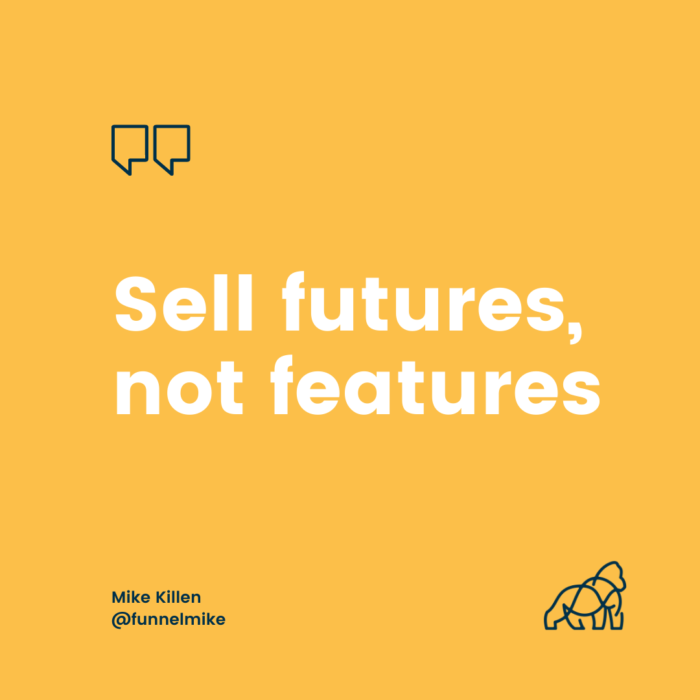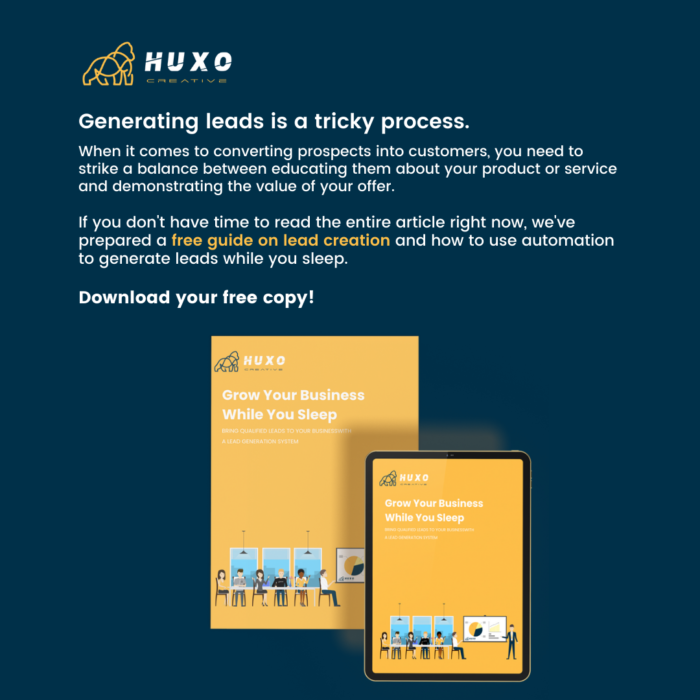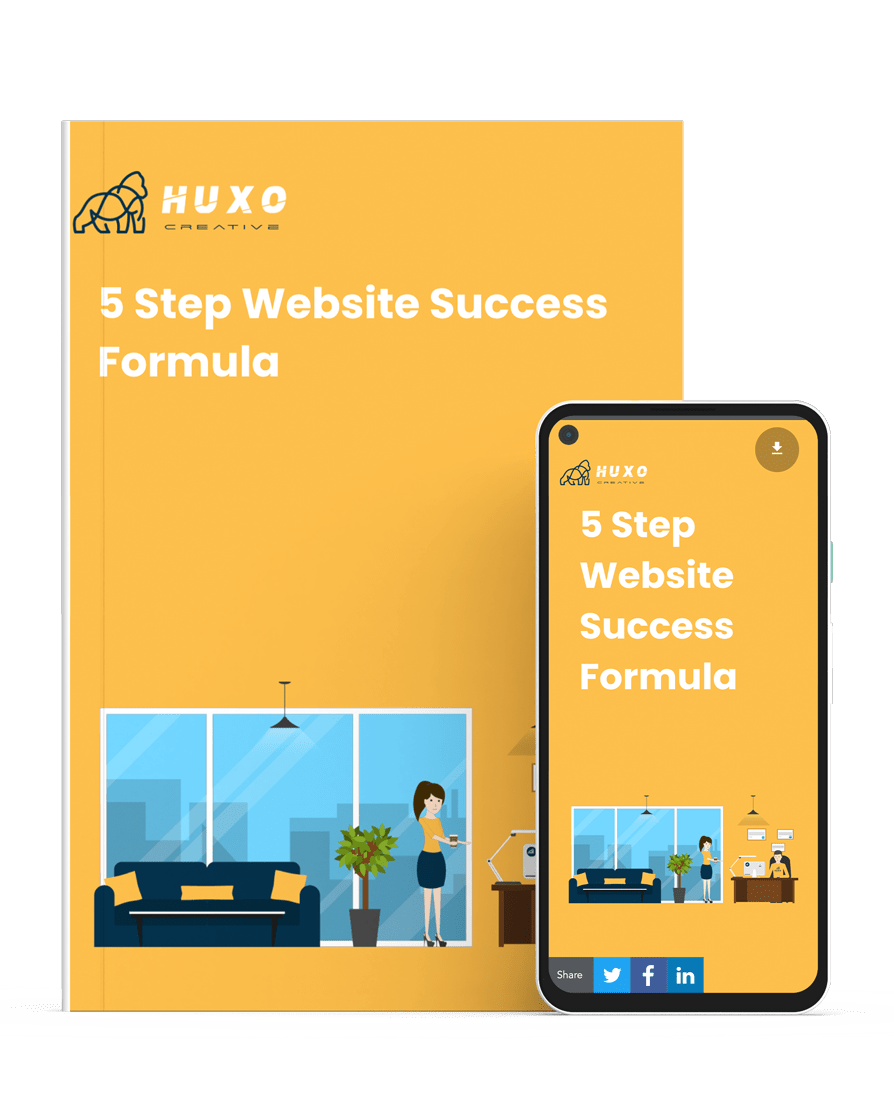What exactly are lead generation websites? And how do you go about building one?
In a nutshell, lead generation websites are designed to bring in qualified leads from your website, increasing your conversion rate and making life easier for your sales teams. A lead is generally defined as someone who has expressed interest in your product or service in some way.
Your lead generation website should target prospective customers and take them through your sales funnel, eventually converting website visitors into leads.
As a leading lead generation agency, we have a few tips on how you can build a high-converting lead generation website.
This article will guide you through the steps of building your lead generating website. We’ll put some meat on the bones and tell you exactly what your website actually needs to add real value to your business.
A quick Google search will provide you with a plethora of information on website creation and design from a wide range of sources.
You'll find endless information telling you the kinds of pages you'll need, which lead magnets, blog articles, landing pages and more. You could spend weeks or months planning out your website, but the essential thing you can do is start today.
Getting started should be your number one priority. You could spend months planning your lead generation tactics, researching lead generation tools and email marketing tools but we've found that the best way to drive sales and turn your website into a lead generation machine is to get started sooner rather than later.
You can always make changes down the line as you grow your digital marketing skills and fine-tune your lead generation process.
The first step is deciding what content your website needs. Some of the most effective content on lead generation websites are videos, blogs posts, infographics, webinars or podcasts related specifically to your industry or business verticals.
Once you've decided on the content you want to include, it's time to start designing your website. The design should be clean, simple and easy to navigate.
Your website should be designed with the user in mind. All too often, businesses make the mistake of building websites that are nothing more than a glorified business card.
Are you targeting business owners? Think about what your target customer wants to see. Research is one of the most neglected but essential components of developing a lead generation website. You must first comprehend your target consumer and what they want.
Only by understanding your target customer can you build a website that resonates with them and encourages them to take action.
75% of users admit to making judgements about a company’s credibility based on their website’s design – Stanford Persuasive Technology Lab
The lead generation process is a delicate balancing act. The right balance between nurture and education will help you convert your prospects into buyers with less effort than ever before!
If you're in a hurry and don't have time to read the entire article right now be sure to get your free lead generation guide before you leave and you'll learn how to use automation to generate leads while you sleep!
Why do you need lead generation anyway?
How much money does your website bring in each month? If you're not using your website to generate leads then you're missing out on a huge opportunity! Your website is the perfect tool to reach new customers, build relationships and close deals without ever having to leave your office.
“Once people find you online, become interested in your product or service and want to know more, they'll know how to contact you thanks to the information on your website, which gives you the opportunity to increase your sales. Even though websites have a cost, when used correctly, they have a positive ROI.” – Kasey Kaplan on why every business needs a website.
OK, now that you know how crucial lead generation is to your company's success, it's time to get yourself a fresh cup of tea and set ten minutes aside to read the rest of this post. You're about to learn:
- Why poor design and low-quality work may cost your business a fortune in terms of money and time.
- Why you’re not focusing on the right area
- How to get your visitors to take the next step
Cheap and poorly designed websites are costly for businesses
Some people believe websites only need to cost £500 – £1000.
“My friend's cousin developed our new website for a few hundred pounds and it looks fine” is a line most web designers and developers have heard a million times.
The problem is, when you cut costs on something as crucial as your website, it will show – and it will cost you dearly in the long run. Your website is typically the first encounter a potential consumer has with your company, therefore it's critical that you make a lasting first impression!
It’s not uncommon for a lead generation website to have poor design and low-quality work – which could cost your business a fortune in terms of money and time! In fact, bad websites cost British firms £60 billion in lost sales according to a Fasthosts study released in 2021.
There are more than 5 million private-sector businesses operating in the United Kingdom alone, and many of them have one thing in common: they're not generating leads from their website.
The average person spends less than two minutes on a website before deciding whether or not to leave. If you don't have a well-designed, user-friendly website, you're likely losing customers and money.
When it comes to lead generating websites, how much should you set aside for the web design cost?
How much you should spend on your lead generation website depends on a number of factors, such as the size of your company, your industry, the products or services you offer, and your target market. However, as a general rule of thumb, you should expect to pay between £3000 – £5000 for a small business website, and between £5000 – £20,000 for a larger site with more features.
While the cost of a lead generation website may seem like a lot of money upfront, it's important to remember that your website is an investment that will pay off in the long run. A well-designed site will generate leads, help you build relationships, and close deals – giving you the time and money you need to grow your business.
You may be thinking, “I have a £1000 budget for my lead gen site. Is a cheap web designer the way to go?”
If you're on a tight budget, the answer is probably no. A cheap web design package may seem like a good idea at first but it's important to remember that you get what you pay for and if your goal is to generate leads and grow your business, you need a high-quality website that reflects the professionalism of your company and most importantly, a website built to convert.
A lead generation website is a tool that should be used to increase sales, build relationships, and close deals. It's not something you should skimp on or cut corners with – if you want your business to succeed, you need to invest in a quality site.
Spending less than £1000 on a new website may work for some businesses, especially those with low-cost products or services that can't justify or don't want to spend a lot on marketing.
However, if you're serious about generating leads and growing your business, it's important to set aside a realistic budget that will allow you to create a high-quality site, or if you're tech-savvy and have the time, learn how to build it yourself.
Building a lead generation website is no easy task but it is entirely possible to build your own and learn as you go if you have the time to and are prepared to put in the effort.
However, if you want to see results quickly, it's important to invest properly in a quality website that will help you generate leads and grow your business. Think of it as an investment that will pay off in the long run.
The bottom line is this: your lead generation website should be an ongoing project that is properly managed, optimised and fine-tuned.
This isn't to say that you can't spend £1000 on web design and end up with a pretty website. Still, if you do manage to hire a web designer for £1k or less for a website that engages your target audience, takes the customer on a journey, and generates revenue for your business, you've probably found a bargain and your web designer should start charging a decent amount of money for their work.
The wide availability of cheap web designers willing to work for little has made the web design industry appear overly saturated. It also means that after a few years or in some cases, less than one year, the typical web design firm or freelance web designer closes up shop, leaving clients with a website that is either no longer maintained or needs to be rebuilt from scratch.
Hiring a web design firm or an agency should not be taken lightly as this decision will have a direct impact on the success of your lead generation website and, in turn, your business.
What if a low-cost website design firm or freelance website designer creates your website and vanishes after a year? Broken links and outdated software will have a devastating effect on your search engine positions.
What happens when your designer is the only person able to edit or maintain the website, and he can’t afford to be in business for long? You’ll have to start from scratch or bring in a professional.
It’s also worth considering that lead generation websites are the most profitable type of website you can have; they're designed to convert visitors into leads and then turn them into sales.
You'll be wasting money if your lead generation website has no clear purpose, no thought process behind it or low-quality work – it's an absolute no brainer!
The second you launch your lead generation website, it needs to be generating revenue.
Don't worry, though; you don’t need a top-notch lead gen site with a great design for that to happen. You need a well-planned website that gets the job done and helps build trust between visitors, consumers, or clients, starting with engaging content.
As a general rule, it's best to avoid any web designer who:
– charges less than £2000 for a small business website
– doesn't have a strong portfolio of work
– doesn't have many (or any) reviews or testimonials
– can't show you examples of lead generation websites they've designed
If you're working with a web designer or web design agency, it's your responsibility to make sure they understand your goals for the website and that they have experience designing and building lead generation websites.
Your website should be a lead generation machine, whether you develop a set of landing pages that are completely separate from your primary site or if you utilise your main website as one big lead generating tool.
The content on your lead generation site should answer questions that visitors may have and help them take the next step towards becoming leads – whether it's making a purchase or signing up for something like an email list.
The most important thing to remember is that lead generation sites do not showcase your company but rather help generate leads.
“It would be great if companies could just magically know what I’m looking for on their website or what I’m coming to the website for.” – Alfred Lin.
How do I hire a web design agency to create a lead generation website?
There are plenty of good web design companies offering lead gen website packages starting from around £3000. It's well worth asking around and researching the type of service you should expect from your web design agency based on your budget.
If an effective lead generation website is within your budget, it’s best to hire an expert web designer who will take the time and effort to understand your business needs and your goals; you won't regret that decision!
Why do website design costs vary so much from one agency to another? Look at it from the agency’s point of view. They know that a lead generation website needs to be optimised for search engines, have great design, and compelling content – all of which takes time, effort, and money.
The agencies that are charging more are generally the ones that will provide you with a better quality service and a higher chance of success.
You should also consider the value of your time. If you're not experienced in web design or digital marketing, it will take you longer to create a lead generation website than someone who does this for a living.
What is the difference between a £2000 website and a £20,000 website?
The answer is usually simple: quality. A £2000 website will likely be built by a web designer working alone in their spare time. They might not have much experience, and they may cut corners to save time and money.
A £20,000 website, on the other hand, will usually be designed and developed by a team of web design and digital marketing experts with a deep understanding of the web and how to create a website that generates leads effectively.
Comparing the cost of different websites can be like comparing houses or cars – you can get a cheap one, or you can get a luxurious one. It all depends on your budget and what you're looking for.
Why is it that a Lamborghini might cost more than £1 million when Dacia makes a vehicle for less than £10,000? They have four wheels and an engine, but one is a high-end luxury automobile while the other is more budget-friendly.
It's the same with web design. You can find excellent quality lead generation websites for less than £5000 or you can spend upwards of £100,000 on a website that looks amazing but doesn't generate any leads.
Some fine-tuned lead generation websites cost more than £20,000 – but even if you don't have this type of budget, you can always opt to start off using pre-built lead generation website templates.
Just don't try to hire a web design agency or lead generation agency if you have absolutely no budget at all.
If you don't have the funds to invest in a lead generation website, you're better off focusing your energies on other marketing channels that will be more effective for your business.
Have you heard of a firm's accounting whiz who does nothing but pro bono work or the fantastic graphic designer who'll work for free in exchange for exposure? Me neither! Although both professions make use of abilities that anyone can learn, both are quite difficult to master. It's true that you get what you pay for.
Wait until your business is generating enough revenue to invest in a lead generation website – it will be worth the wait!
A lead gen website is one of the most important investments you can make for your business – so choose wisely and don't cut corners.
There are so many different types of lead generation websites and it can be tough to know where to start. We've found that the best way to approach this is by thinking about what kind of leads you want to generate and what type of website will be the most effective for that.
For example, if you want to generate leads for your boutique hotel you'll need a website that's designed to capture leads and enquiries from potential guests.
On the other hand, if you're a lead generation agency, you'll need a website that showcases your work and helps
These days, brochure websites aren't cutting it. Gone are the days when having a website alone was enough to get your business noticed online.
Why do you need lead generation?
If your website is a true asset for your business, it should have a measurable impact on your earnings.
Your website should bring new leads, sales and better relationships with your customers.
Just having a website isn’t enough for your business; You need to produce relevant content for your audience regularly. Being helpful to your audience should be your top priority.
Lead generation is a core part of the sales funnel for many B2B companies since their products can cost thousands of dollars and web visitors are less likely to buy their product or service directly from the website. – Optimizely.com
You can't expect to reach your target audience if you don't know who they are. It will be impossible for you to succeed if you don't know who you're trying to contact.
No matter how important your cause is, attempting to appeal to everyone or get everyone to give won't generate a rush of cash.
You need to understand your target audience and speak to them, be useful to them, and provide interesting, relevant content. If they find it useful, others will too.
You're competing with so much more than your own competitors. On the internet, distractions are everywhere, and everyone attempts to grab your attention.
You'll attract more readers, viewers, and listeners if you provide useful, intriguing material that people want to read, watch and listen to. It's as easy as that.
Having dedicated landing pages for each service or each geographic area, for instance, can massively improve your search engine position for certain keywords, putting you in front of more potential clients.
What's the cherry on top? You'll need to gather email addresses and new leads to market to them effectively. Your website can only take you so far but it can help you boost your email list with a significant number of people who are ready to pay you money.
Consumers are increasingly concerned about what they see before making a purchase. As a result, content is becoming more significant in the purchasing process:
9 out of 10 B2B product or service buyers say that online content has had a moderate to major impact on their purchasing decisions – Lenati
What are the different types of lead generation software tools?
Because there are numerous methods to generate leads for your business, there are several distinct types of lead generating tools and strategies that you can utilise to help. They are as follows:
- Advertising Tools: Using Facebook Ads, Google Adwords and other paid channels, you can boost your website's traffic and drive visitors to specific pages on your website.
- Communication Tools: Chatbots are effective tools that can help you to communicate with your target audience and generate leads in real-time.
- Content Tools: Creating helpful blog posts, guides and interactive content is a great way to attract new visitors to your website and get them interested in your products or services.
- Customer Relationship Management Tools: Bring leads into your CRM and track their activity across your website and sales funnel to better understand their needs and how you can help them.
- Email Address Finders: Connect with people who aren't on your email list
- Email Marketing Tools: Nurture those leads with campaigns to keep them engaged with your brand
- Event Marketing Tools: Webinars, conferences, and other gatherings are fantastic methods to win the confidence of your target audience.
- Prospecting and Outreach: Identify potential leads by collecting contact information from anonymous visitors and sending out follow-up messages.
- Sales Tools: Companies use sales tools to convert leads into paying customers while also maintaining contact with current customers.
- SMS & Web Notifications: You can use marketing automation to send out automated email and SMS campaigns to your subscribers. These messages can be triggered based on certain events, such as when a lead visits your pricing page or downloads a piece of content.
It's incredible how much information there is to absorb. If you try to do everything at once, you'll end up overworking yourself, which will cause strain and frustration.
We've discovered that instead of attempting to use several lead generation methods at the same time, it's better to concentrate on one or two strategies that are effective for you and your team before mastering them. Once you've done that, you can move on to other tools and strategies. The important thing is to not get overwhelmed and to take things one step at a time.
The best lead generating software for your business is one that is affordable, helps you achieve your objectives, and that you feel confident using.
We've only given you a very basic overview of the types of tools you can use. If you want to know more about the best lead generation software, take a look at the best lead generation tools for your business by OptinMonster.
Now that you know what lead generation is, as well as the different types of lead generation software tools available, it's time to start generating some leads!
3 Things Hampering Your Conversion Rate
1) Failing to update or maintain your website and landing pages
Sometimes the most basic issue to address with a broken website (and something that everyone will encounter at some time) is updating the software behind it.
If your website is slow or broken you're likely losing out on potential customers.
It might be hosted on a server that isn't powerful or quick enough for your needs. For websites with static content, low-cost website hosting can work well. However, if you have a lot of traffic or your website is expanding, it's probably time to switch hosts.
Additionally, your website might not be set up to handle high traffic loads very well. If this is the case, you need to investigate how to make some changes so that your site can stay online during busy periods.
One of the biggest areas for improving website load times is image optimisation. If you've uploaded high-resolution images to your website without making changes
You have a lot of high-resolution images on your website, which is probably slowing down your site.
If your hosting is bad or you aren't optimising your website effectively, it won't load quickly enough.
If it takes more than a few seconds for them to load, they will leave and go somewhere else, and Google will penalise you for a slow website, just as they do for websites that aren’t mobile-friendly.
The use of invalid HTML or CSS is also known as a ‘broken code.' There's an entire list of possibilities for your website to break.
Website updates, core software updates, and changes to the platform can all break a website, even if it was working fine before any changes.
The fact is that if you don't have a properly backed up, regularly updated, and well-maintained website, it will eventually break.
Finally, the most frequent reason sites break or slow down is because they aren't properly secured.
If you're not taking the time to protect your website with an SSL Certificate, you could be opening yourself up to a world of trouble.
Your site will load more quickly for visitors if it is compressed. This can be easily done by installing a plugin like WP Super Cache or WPRocket on your WordPress website.
Not compressing images can lead to large files that will slow your website down.
Compressing images can be done using a tool like TinyPNG or you can automatically use a WordPress plugin like ShortPixel to do it for you.
You could also minify JavaScript and CSS files, but this isn’t always necessary if your theme is already doing a good job of compressing its files.
Don't make the mistake of thinking that your website is secure if you have an SSL certificate.
You can get a self-signed SSL certificate for free that will protect your site from visitors' prying eyes while they are on it, but once they leave and go to another site or share a link with someone else, their browser will show a big, red warning sign.
Your website's security is only as good as your weakest link.
If you have an SSL certificate and are still not using a CDN, then you're missing out on a lot of speed benefits.
A Content Delivery Network (CDN) like Cloudflare will help distribute your content all over the world, which will then help load it more quickly for visitors.
Many business owners mistakenly think that once their website design project is ready for launch, it's finished. The fact is that your lead gen website will never be “finished,” since it's always an evolving process to be maintained, monitored, and enhanced.
Keeping your website's design and development up to date is crucial not only for the sake of aesthetics and providing up to date information but also for security purposes.
Your website may be vulnerable to hackers if you don't have adequate hosting or a regular website maintenance plan. Sometimes you won’t even notice it, but visitors to your website will.
Detecting and removing malware from your website can be difficult since it can be so hard to spot in the first place yet it's a deal-breaker for consumers and will cause you major issues if you don't deal with it promptly.
If your website is affected by malware, you may see a sudden drop in traffic, or your website may be inaccessible altogether.
Fortunately, prevention isn't tough and it certainly costs a lot less than unexpected downtime can cost you dearly in terms of both money and reputation, which is why it's so important to have a plan in place.
Unfortunately, repairing your reputation if your consumers' data is stolen is much more difficult. It's up to you whether or not you're willing to take the risk.
More than 80% of the websites that are hacked is because they were not being updated – Malcare.com
How can you prevent your lead generation website from being hacked?
There are a few key things you can do to prevent your website from breaking or being hacked, although it is worth pointing out that nobody can promise that these steps will make your website 100% hackproof. However, taking these precautions will help to protect your website from malicious attacks.
- Use two-factor authentication
- Use a strong password for your website administrator account and change it regularly
- Use a secure hosting provider
- Install a website security tool like Wordfence or Succuri to protect your site from common attacks
- Keep your website and plugins up to date to reduce the risk of vulnerabilities being exploited
- Regularly back up your website so you can quickly recover if something does go wrong
- Use a CDN
- Monitor your website for signs of malicious activity and respond quickly if you suspect an attack
Make sure your website is updated with the latest security patches, keep all of your passwords private, so nobody else can easily access them and have a secure hosting plan in place. And always have backups.
We're here to help if your current WordPress website needs some maintenance. Find out how our WordPress care plans can make your life that little bit easier.
2) Failing to focus on your customers
You've undoubtedly noticed it yourself; company websites, intended to promote items or services to other businesses, feel the need to inform you what each member of their staff does in their spare time, the more ‘out there, the better.
It's not unusual for these websites to lead off with an ‘Our Team‘ section, listing each staff member.
“When he’s not in the office crunching the numbers on your accounts, Hugo loves nothing more than making his own soap from his own leftover artisan coffee beans that he handpicked, washed and roasted during his time backpacking around Cape Verde”.
Now, hats off to Hugo for having a hobby, but none of that is relevant. How about something closer to the truth? “When he’s not sat at his desk checking Facebook or doing his weekly shopping, Rich can usually be found having a cheeky smoke outside with his colleagues or trying out his best pick up lines on the new girls”.
At a more understandable level, we see numerous businesses producing content for the wrong audience.
Your website should be all about your potential customers, not about you. When you talk about your team, it's great to have a little fun, and no one wants to do business with a company that takes itself too seriously.
People buy from people, so it's essential to have some photos and bios of your team members on your lead generation website but remember that potential customers need to understand what's in it for them.
While having a wealth of information about your staff on your website is beneficial, your customers would rather see answers to their issues than introductions to the people who might be able to help solve them.
Remember that you're trying to attract customers, not make friends. Keep in mind what your lead is looking for and give it to them in a way that's easy to digest.
Your website is not the place for you to tell your life story – save that for your blog.
We've found out that less is often more when it comes to lead generation websites. You don't want to stress out over details unless they're essential. Focus on developing helpful information and making it accessible to potential leads.
To discover keywords that are relevant to your product and integrate them into your writing, use a keyword tool to help you find easy to rank keywords to target. There are too many useful keyword tools for me to mention just one, but some of my favourites are Ahrefs, SEMRush, KWFinder and Moz.
There's a lot more to being found in search engines than stuffing keywords into your content, but it's a good idea to get started getting with the habit of putting your desired keywords into your written content.
If you're going to write a lot of your own website content, you should start using keyword-rich titles, descriptions, and headers too.
Your content should talk to your audience.
Instead of talking about the quality of your product and detailing numerous features, you should instead explain the advantages of your offering and the benefits of buying from you.
Avoid using jargon or technical terms unless your website will only be visited by other businesses in your field who will understand it. It's great that you understand what you're saying but if your target market doesn't will they take the next step and contact you?
Explain how your customer's life is going to be different if they buy from you. What will change? Your potential customers have a problem that needs solving, and your job is to show them how you can help.
Imagine trying to sell a luxury holiday by talking about the expensive interior of the hotel and the luxury furnishings. That's not going to work, is it? You need to focus on the experience that your customer will have.
Paint a picture of the beautiful weather, clear skies, sandy beaches, the sound of the waves crashing and the cocktails by the pool. Talk about the experiences and memories that will last a lifetime. That's what you need to focus on.
If you spend more time telling the client how their life and business will be improved after working with you, they won't care what name you call your product.

When a customer buys from you how do they feel?
How is their life better after? How is that business better? How is their relationship with their family? Will your product assist your clients in business, allowing them to spend less time at work and more time with their families at home?
These are all the things that people are buying.
People don’t buy beds, what they buy is a better back and a better night’s sleep.
People don't buy smoothies and diet pills; what they want is weight reduction and self-esteem, the promise of a slimmer, healthier, and happier version of themselves.
What are the emotions that your product or service evokes?
If you’re not sure, ask your customers or even better, ask people who haven’t bought from you yet. When they see your product or service, what do they feel?
Use those feelings and emotions in your copy. Think about how your product or service can make a difference in someone's life and then communicate that to them.
If you work as a business coach you could create content to help your clients succeed. Give away ideas and share your knowledge to help others improve their businesses.
Be active and helpful on social networks and use your email contacts to reach out to former clients and potential leads.
When someone comes to your website, they are more than likely not going to become a lead unless there is enough educational information.
Put educational content on your blog and in social media posts to teach people how to use your product. When you make your website about solving problems for others, you're on the right track.
Keep it simple, focus on quality information and lead with what potential customers want to see: solutions to their problems.
Be seen as an expert in your field and people will come to you when they're ready to buy.
If you can do that, you'll be well on your way to generating leads from your website.
Don't be like other businesses that only talk about things that appeal to people in similar industries.
Finally, make sure to include a lead-generating call-to-action button.
You need a good call-to-action (CTA) to generate leads from your website.
A call to action (CTA) is text or an image that entices users to take the desired action, such as signing up for newsletters, calling sales reps, or obtaining more information. Get into the habit of making offers!
Use a strong call to action button on your website and begin scheduling sales calls as soon as possible.
TLDR; Many companies devote time and effort to creating content that is far better suited for reading by their peers and rivals. Write content for your ideal customer and use a solid CTA to turn readers into leads.
3) A Lack of Content Marketing
Finally, and frequently, you need to be producing content regularly as well as maintaining the information on your website current.
It's all too easy to lose momentum after your website goes live. You may not be sure what to write about, or you may be running out of time, but if you want to be generating a huge number of leads through your website you need a constant flow of outstanding content.
Blogs have been rated as the 5th most trusted source for accurate online information – HubSpot
For success, your lead generation website needs to be growing constantly and changing with the times.
You may not have enough time to create new material every day or week – but you should try! Even if nothing is going on in your company now that would appeal to potential leads, write about something else.
Everyone struggles with lead generation at some point, but you can overcome these hurdles by being creative and thinking outside the box when it comes to content creation.
If you want to generate leads from your website, try creating something useful to the ideal client that you can give away. This could be as simple as a checklist or a helpful video.
When you lead with what your lead wants to see they'll be much more likely to respond and contact you for help.
Even if you think your ideal consumer is “everyone,” unless you have Coca Cola or McDonald's' marketing budget, you'll struggle to connect with your target market. It's far easier and more effective to focus on a specific type of person that you can help, and then write content for them.
It took me longer than I'd like to admit to actually stop trying to market to everyone, in part because I wanted to reach out to as many people as possible and also because I was too worried that by focusing my efforts on one person I would lose sales. I couldn't have been more wrong.
It’s important to regularly put relevant, valuable content out that your audience wants to read about, watch, or hear. As your library of content grows on your website, you can add internal links to your other content.
Use email automation tools to send out new articles to your email list. Forbes predicts that automation will become a large part of lead generation strategies, specifically when it comes to streamlining lead qualification and predictive scoring.
If you're stuck in a rut and want some inspiration to get your creative juices flowing, we've got you covered. Take a look at some of Janet Murray's Courageous Content podcast / blog where she provides helpful tips and ideas for content marketers.
It doesn't sound easy, but it’s not once you have a solid process in place to create new content. If you’re struggling with what to come up with or how to put it together, we can help.

3 Steps to Turn Your Website into a Lead Generation Machine
Step 1) Post new content regularly
First, you need to commit to producing one new piece of content each week. It's that easy. And it's not quite as bad as it sounds if you have a system and a plan in place.
An easy way to kick this off now is to write down five broad topics that your target audience wants to hear and that you can talk about.
So, if you’re a chiropractor, think about five basic topics that come up between you and your patients or five topics you could put everything under. For instance, back pain in pregnancy, lower back pain, sports injuries, exercises to ease back pain, and things you can do to prevent pain.
- What are the most commonly asked questions you’re asked about each of those topics?
- What do you get the most calls and emails about?
- What things do you find yourself having to explain repeatedly to different people?
The answer to each of those questions could be turned into a blog post, a video or a podcast episode. You could create a frequently asked questions post to point people towards.
Think about topics your customers SHOULD know about or would benefit from knowing. What would they need some help with? What are you an expert in?
Once you have your topics it's time to start writing headlines for each of them. This will help when it comes time to create the content – you can work off the headline. Don't worry too much about crafting the perfect headline, you'll be far more productive if you focus on getting your ideas onto paper first.
Do write content where you:
- Tell stories about how your services have helped people.
- Give away tips on solving problems your customers face.
- Recommend products that you think your audience would benefit from.
What sets your company apart from the competition in your field? What was it that made you go into business in the first place and what drives you?
Why should anyone be compelled to visit you? Tell people about it. Maintain an engaging conversation with your prospects by telling them about YOUR company and what sets you apart.
Even if you only come up with three questions for each of your five broad topics, that’s fifteen pieces of content already.
Step 2) How to tell qualified leads what action to take next
So, someone has read your post (high five!), and now we want their details. We want them to become a lead.
Now, we could just put a big, fat, ugly lead capture form at the end of our blog post and hope they fill it in (but that's not very inviting).
We need to think about what we want people to do when they've finished reading our content. Do we want them to call us? Fill in a lead capture form? Visit our website? What is the next step you'd expect someone to take?
Once you know what action you want people to take, it's easier to design a CTA (call-to-action) that will lead them there.
If you want them to fill in a lead capture form, make the form easy and quick to fill in. If you want them to call you, make the phone number big and easy to see (and have a lead capture form on your website so you can collect their details that way).
Make sure your CTA is designed in line with the look and feel of your website – it should be consistent. Make your call to action button stand out by using a contrasting colour.
And, finally, use persuasive language that tells the reader what they need to do – “Download your free guide now,” or “Get in touch today for a free consultation.”
The aim here is to want them to give you their email address and contact details so you can market to them.
How do you get them to hand over their information? You offer them another useful, precious piece of content in return for their email address.
Ask them: “If you liked this post about [topic], then you’re going to love our podcast/checklist/guide/video on [topic]”.
Make them want what you’re offering and make it worth their time. Focus on the value someone will get by handing you their contact details, especially their email address. Make sure you explain exactly what they need to do in order to get their hands on your content.
You could say something like: “To download our free guide, simply enter your email address in the form below and we’ll send it straight to your inbox.”
After reading your blog post, what would be the next logical steps for someone? For example, if I’m reading a post about setting up a WordPress website, the next step could be a guide on how to get WordPress installed and set up properly.
Your next step should be related to the original content they’re consuming. Make it a next step or a bonus. What would someone REALLY want to read or do next if they were reading your awesome content?
Step 3) Keep it simple for a better user experience
Don’t overcomplicate your website design.
White space is good.
Large areas cluttered with text put people off.
Make it easy for people to use and read your content by keeping white space and keeping it uncluttered.
Limit the colours you use to a few on each page – Many people think that great design necessitates the use of many different colours. It doesn't, and it's all about using just a few effectively. Don't go crazy; less is more in this case.
- Good images are nice – When you can’t use real photos, spend 15 minutes or so to find high-quality stock images (they can even be free from the likes of Pixabay, Pexels, Unsplash or bought from Shutterstock or DepositPhotos) and help people visualise the story you’re telling them.
- Break the text up – People skim posts to find what they’re looking for. Keep it minimal, whatever the length of your post, and separate points. Prioritise the points you want to get across.
- Focus on one Call To Action for each post/page – Don’t ask your reader to do more than one thing; they’ll end up doing none of them. Make it easy for them to take the action you want them to take next. Something like ‘download a free guide’ or ‘book a call’, not both. Don’t overcomplicate it.
In Summary
We love the idea of saying “if you liked that, you’ll love this” for the next steps. We use it on landing pages and blog posts all the time.
Your lead capture form must be easy to fill in. If it takes too long people will get impatient and leave before they’ve had a chance to sign up for the next thing you want them to do (which could be anything from buying something on your website right through to giving you an email address to add to your list).
“Why should we pay £5000 for a website when a guy down the street charges £500 for web design services?” is a typical question.
And we hear what you're saying, but over the years, we've learned that if you invest wisely in your website design project, you'll end up spending less time and money trying to fix things later down the line.
Don't be afraid to share your knowledge, either. The idea of giving valuable information away for free can be scary but think about it this way.
If you give away good information to people on your social media pages or blog posts, they'll be more likely to want to buy something from you in the future.
How do you get people to hand over their information? You offer them another useful, precious piece of content in return for their email address – something they can't find anywhere else.
You don't need to hire someone or spend much time on creating your first lead magnet to give away either; a simple checklist or cheat sheet can be knocked up in Word or Google Docs in no time at all.
Once you have their email address, the sky's the limit in terms of what you can do to keep them engaged with your content and, ultimately, lead them into becoming a paying customer.
So there you have it! A simple guide on creating a lead generation website that brings new leads into your business.
You must invest to get anything out of it. Before you can get anything out, you must put in a certain amount.
Takeaway: The Key to Successful Lead Generation
- Don’t shop around for cheap web design if you're serious about growing your business. Comparing local web designers and web design agencies by price is never a wise decision.
- The cost of a low-cost website will usually end up costing you more money in the long run, either in lost revenue or the expense of repairing problems when they arise, and the cost of restarting your web design project from scratch.
- Good design that generates a return is simple, not complicated.
- You need to create valuable content that your audience wants to read regularly.
- If you want a lead generation website that brings in new leads, then invest wisely into your website design project from the beginning.
- It's not as hard as it may seem to create a lead magnet – in fact, you can probably knock one up in an hour or so using some simple software like Word or Google Docs.
- If you want your lead magnet to be effective, it has to provide something that people can't find elsewhere in the market.
Once you have someone's email address, there are no limits to what you can do to keep them engaged with your content.
Don't wait any longer; get started today!
Knowing where to start can be overwhelming with so many different lead generation strategies to choose from. If you want to cut through the noise and learn our proven method, download our free guide on lead generation strategies today. It's packed full of information to help you get started.
You'll learn about one of the most successful methods in modern-day marketing: automated nurturing! Learn how to choose the best email marketing solution for you, then integrate it with your website to create a lead generating machine that can start nurturing prospective customers right away.
Download your free lead generation guide now!
Or, if you're not quite ready to implement the steps in the lead generation guide yet you can sign up for our blog and we'll send you our latest articles on lead generation straight to your inbox.

















